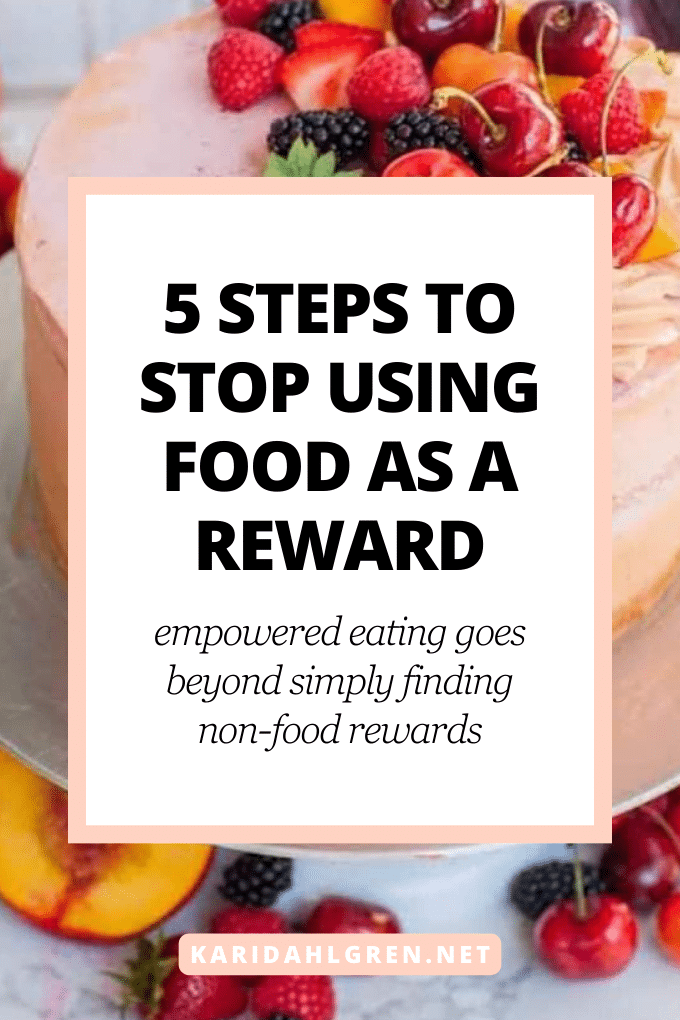
Have you ever reached for a slice of cake or a bag of chips as a treat for getting through a tough day? Many of us are familiar with the ritual of using treats to reward ourselves, but this habit can be hard to break.
Known as hyperpalatable foods, these snacks are packed with fats, salts, and sugars that trigger our brain’s reward system, making them irresistibly appealing. If we use hyperpalatable foods to reward ourselves after accomplishing a task, it becomes even more complicated to learn how to stop using food as a reward.
I’ve been there many times before, sitting at my desk and promising myself that I can have a chocolate square once I finish the project at hand. It was an attempt to feel more in control around food, but as you’ll soon see, rules and restrictions only diminish our personal power.
To break the habit of rewarding yourself with food, it’s important to understand why we’re wired to turn to food for comfort and stress relief. Then, we can explore ways to incorporate non-food rewards into the mix without stirring up feelings of restriction or deprivation. Instead, the focus is on nourishment, enjoyment, and empowerment.
Why Do We Use Food as a Reward to Begin With?
Understanding why we reach for sweet, fatty, salty foods as a reward involves a deep dive into the psychological and biological connections between eating and pleasure. Even if you don’t use hyperpalatable foods as a reward, it can still help to understand the brain science behind reinforcement.
Here are compelling reasons for gravitating towards food as a reward:
The Feel-Good High of Dopamine
When we eat a sweet treat as a reward for completing a task, the brain triggers the release of dopamine, a “feel-good” neurotransmitter that plays a pivotal role in our brain’s reward system.[1]
Sweets aside, a study published in the journal Neuron reveals that when we get a specific reward at the end of completing a task, it also triggers dopamine release.[2] Although non-food rewards can trigger dopamine, sweet treats carry a more potent punch, making them a commonly used “food reward.”
Stress Increases Cravings for High-Reward Foods
When food becomes a reward, we not only benefit from the feel-good rush but we also – intentionally or unintentionally – use it to cope with stress. Studies have found that stress intensifies cravings for hyperpalatable foods.[3] If you ever find yourself stressed and craving foods high in fat, salt, or sugar – like potato chips or chocolate covered almonds – biology plays a strong role.
This explains why it’s easy to use food as a reward. When we have a stressful task in front of us, the stress increases a desire for “snacky” foods. If we don’t want to indulge in such treats, we may use the task at hand to delay the indulgence.
Weight Loss Increases Cravings for High-Reward Foods
Using food as a reward is one way that some dieters attempt to delay their intake of food in an effort to lose weight. However, this behavior is harmful as it may contribute to an unhealthy relationship with food, where hunger — a natural physiological cue — is ignored or overridden by willpower.
This can lead to disrupted eating patterns, like binge eating or excessive restriction, as the body’s natural signals are not properly addressed. Rewarding oneself with food after withholding it can also reinforce unhealthy habits that equate food with emotional satisfaction rather than nourishment, potentially leading to cycles of overeating and guilt.
How to Stop Using Food as a Reward: 5 Ways to Apply Eating Psychology
There are many well-intentioned reasons for using food as a reward, and understanding the potential causes and consequences can help pave the way towards new behavior. Up next, we’ll explore the steps for learning how to stop using food as a reward by unraveling the psychology of our eating habits.
Here are steps you can take to deprogram the habit of using food as a reward:
1. Make Sure You’re Not Undereating
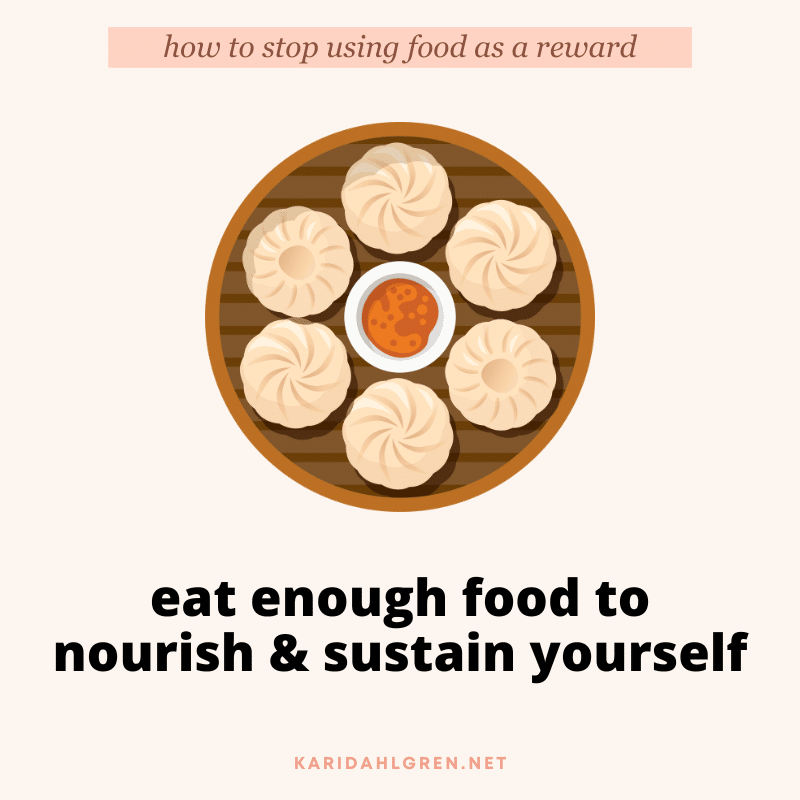
The first step for relinquishing food as a reward is to make sure you’re eating enough food to nourish and sustain your body. This helps diminish unnecessary cravings for hyperpalatable foods caused by “famine brain.” When you reduce cravings for fatty, salty, and sweet foods, you’ll be less inclined to use them as a reward.
If weight loss is your goal and you believe that you can’t consume more food without gaining weight, I strongly recommend reading about set point weight theory. In a nutshell, your body is highly adaptive and turns the volume on your metabolism up or down based on how much or how little you’re eating. Eating less doesn’t necessarily lead to long-term weight loss, and it is even linked with a higher set point weight in the long-run in some cases.[4]
2. Give Up the Food Rules
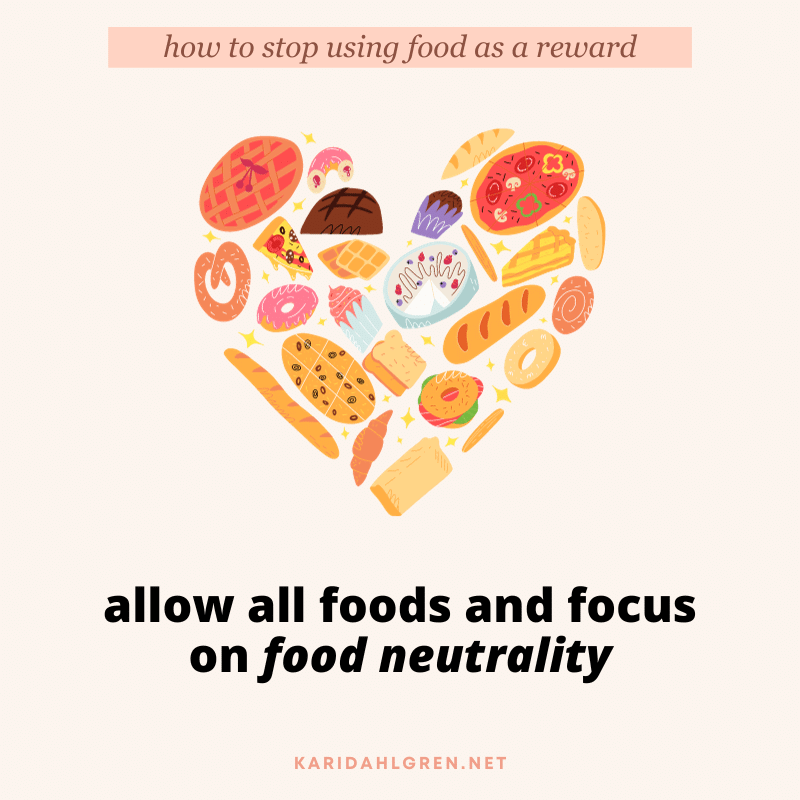
Dietary restrictions and self-imposed food rules can inadvertently worsen our relationship with food and intensify our desire to use food as a reward. When certain foods are labeled as off-limits, they not only become more psychologically enticing, but our preoccupation with them increases.[5] Therefore, letting go of the food rules is a great next step towards learning how to stop using food as a reward.
Instead of operating within the confines of what’s “allowed” or “forbidden,” aim to foster a positive relationship with all foods. Embrace that food isn’t inherently good or bad and view it more neutrally. This will help diminish its allure as a special “reward.” Over time, by aligning more with intuitive eating and listening your body’s cues, you can break free from the cycle of using food as a reward.
3. Use Non-Food Reward Strategies
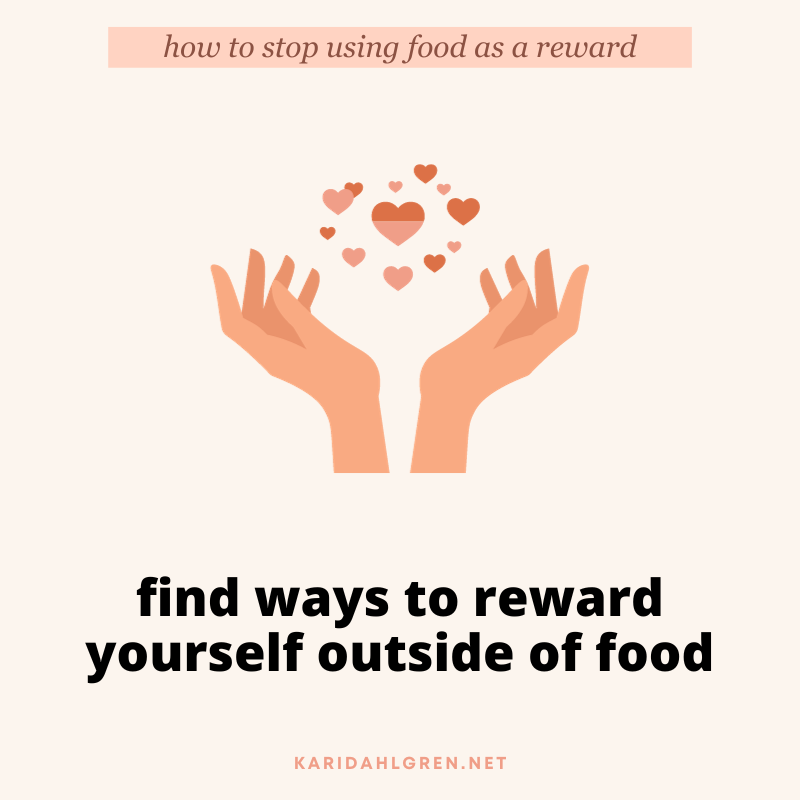
Notice that this is the third step and not the first. If we attempt to replace food-based rewards with non-food rewards without first addressing the fundamental needs for proper nutrition and understanding the psychological dynamics of food cravings, we may continue to experience strong cravings.
Furthermore, if food-based rewards are currently used as a mechanism to delay the consumption of craved foods, it would only only intensifies the internal battle over food, depriving us of the satisfaction from enjoying the foods we crave. Once your physical body is nourished and your diet provides essential satisfaction and joy, then we can move on and explore non-food reward ideas.
Here are some creative options for non-food rewards:
- Self-Care Rituals: These can include activities such as taking a short walk (if you find it enjoyable), watching a funny cat video on YouTube, or indulging in a hobby you love for a brief moment.
- Materialistic Rewards: This can be an item you’ve desired for a while, be it a book or a handy gadget. New items can feel good, especially when they align with our values. However, it’s crucial to be mindful of your budget because, just as with food, shopping can become compulsive.
- Shopping Without the Purchase: Not all rewards need to be purchased. You can get the feel-good experience of consumerism without actually spending money. Ever heard of The Target Effect? It refers to the phenomenon where stores like Target can be enjoyable and mentally rewarding even if you’re just browsing.
I also want to emphasize that your reward must actually feel good, otherwise it won’t trigger the desired dopamine release. For example, you might feel inclined to use a short walk as a non-food reward because movement is good for the body. However, the enjoyability of a walk depends on your energy and stress levels. Stay mindful of overly virtuous goals and focus on things that feel good in the moment.
4. Try the Stop, Drop, & Feel Technique
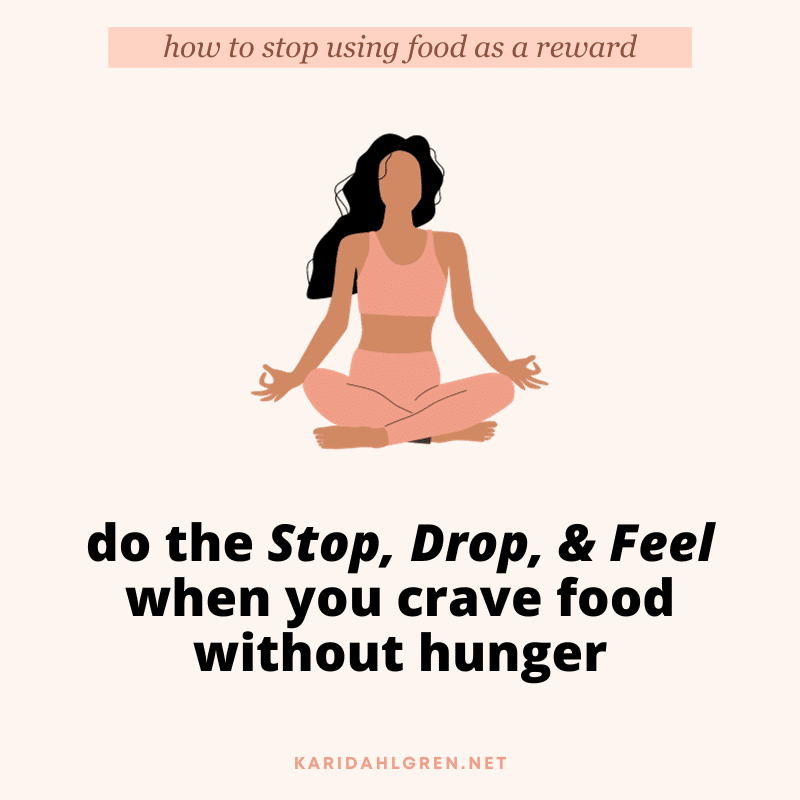
What if your urge to use food as a reward feels compulsive? What if, despite your best efforts to choose non-food rewards, you find yourself repeatedly drawn back to using food in this way? This is where my Stop, Drop, & Feel technique can help.
To combat the urge to use food as a reward, employ the Stop, Drop, & Feel during the precise moment when you want to eat when you aren’t hungry. The goal is to develop emotional awareness and emotional tolerance, or your ability to feel uncomfortable without being swept into compulsion.
Here’s how it works:
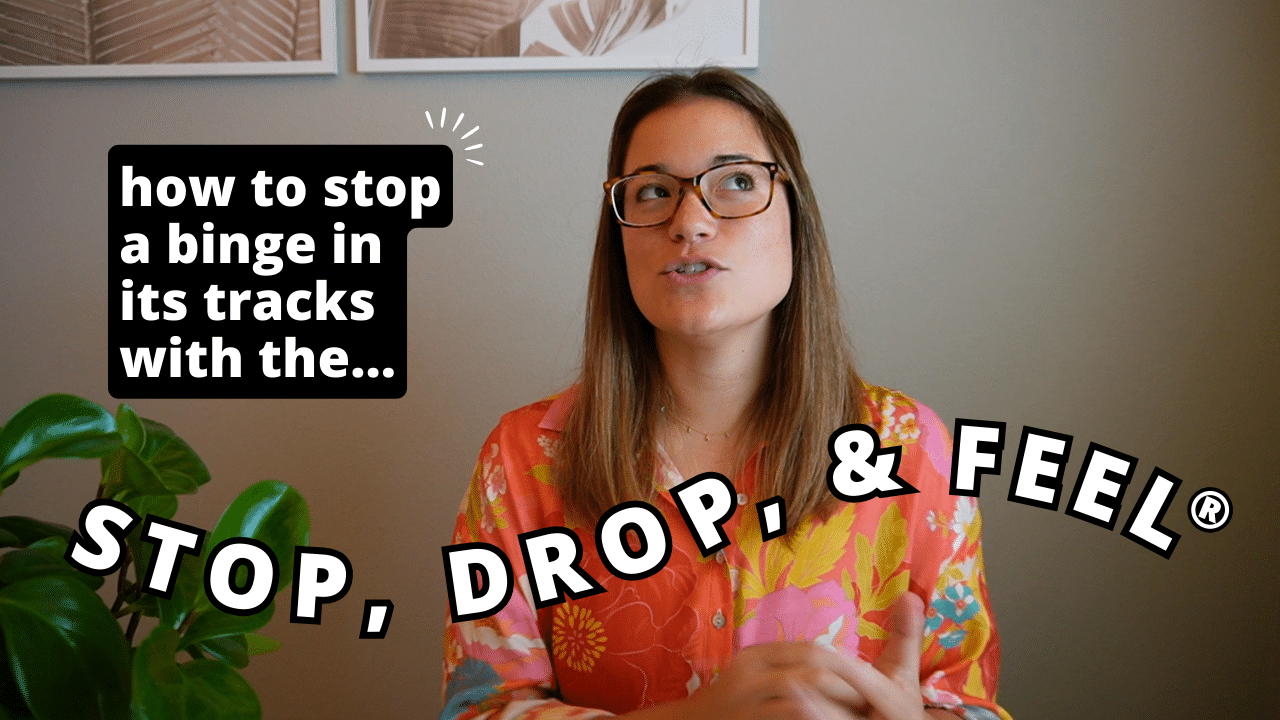
- Stop: The moment you feel the urge to use food as a reward, or any other compulsion, pause. Give yourself permission to eat the food later, after the SDF technique, if that’s what you still want. This helps prevent feelings of deprivation and otherwise triggering the restrict-binge cycle.
- Drop: Change your setting if possible, even if it’s just moving to another room. Set a timer for two minutes and drop into your body. Then, get curious about what’s there.
- Feel: Allow yourself to fully experience whatever emotion(s) bubble up. Avoid analyzing or resisting them. Simply observe the emotions, feel them, and allow them to coexist with you for those two minutes.
The underlying philosophy of my Stop, Drop, & Feel technique is that beneath every craving for food without hunger, there’s a suppressed or unrecognized emotion that needs attention — hence we chase the feel-good dopamine rush of food as a reward. By pausing and allowing ourselves to sit with these emotions, we build resilience and emotional tolerance. This act can weaken the impulse to use food as a coping mechanism.
5. Practice Mindful, Attentive Eating
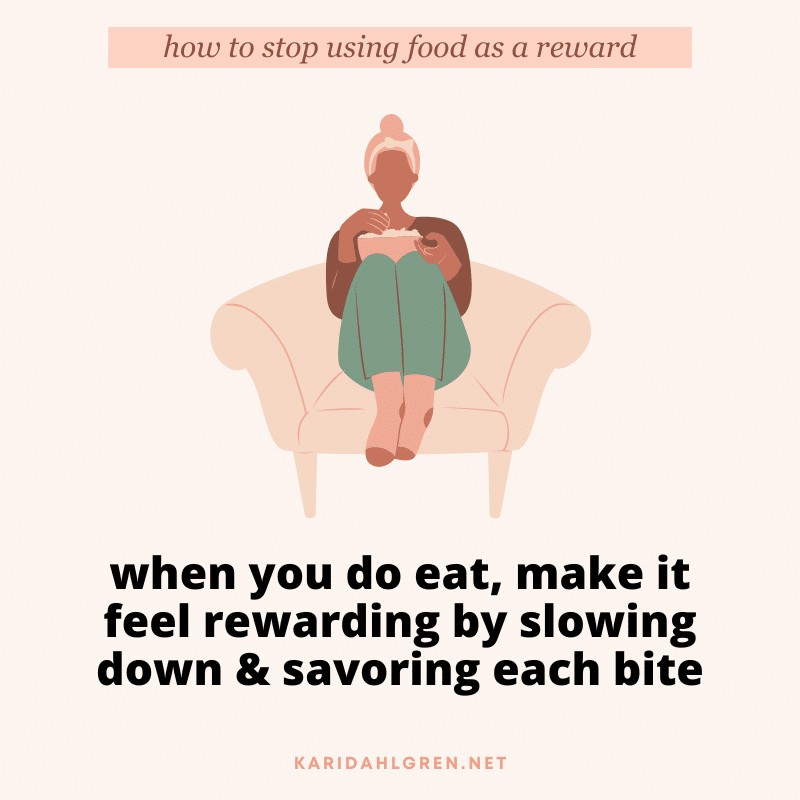
Mindful eating is last on this list but certainly not least. Studies have shown that slowing down your eating speed can significantly decrease the amount of food that you eat and increase feelings of satisfaction.[6] This suggests that when we savor our food, we may need less of it to feel rewarded.
Similar research highlights the downside of eating while distracted, linking it not only to eating more food but also eating more food later on.[7] By being more present with your food when you eat, you become less likely to overeat or use food as a comfort mechanism.
Deprogramming the Pattern of Using Food as a Reward
Food can indeed be a delightful part of our lives, enriching our experiences with joy and satisfaction. However, when we start manipulating our eating habits by restricting certain foods or saving them as rewards for later, we may unintentionally deepen the internal battle around food.
By stepping away from rigid rules and embracing a more balanced approach to eating, we can enjoy food as one of life’s simple pleasures, free from internal conflict. Then, when we add non-food rewards into the mix, it can come from a place of empowerment rather than control.
If you’re interested in learning more ways to heal your relationship with food, I have plenty of resources for you below:
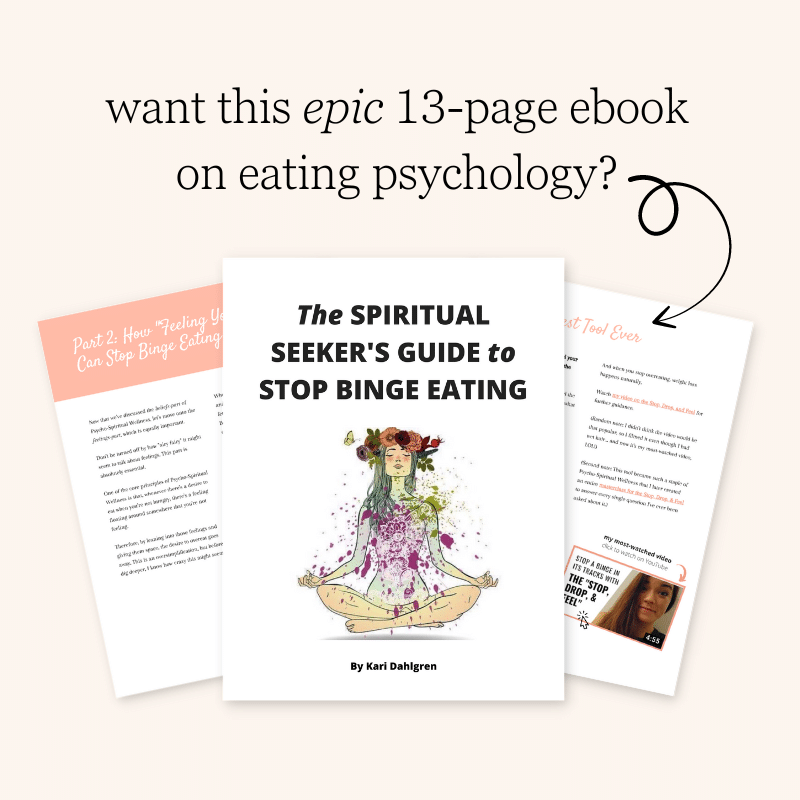
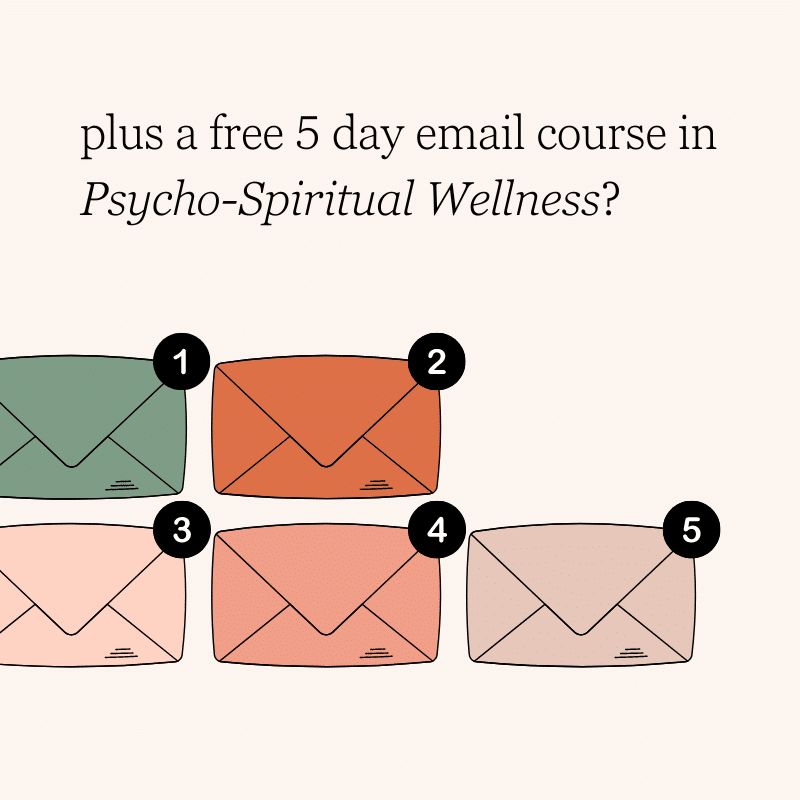
![best seller [cover of Why We Do the Things We Do]](https://karidahlgren-net.b-cdn.net/wp-content/uploads/2023/09/why-we-do-the-things-we-do-1.png)
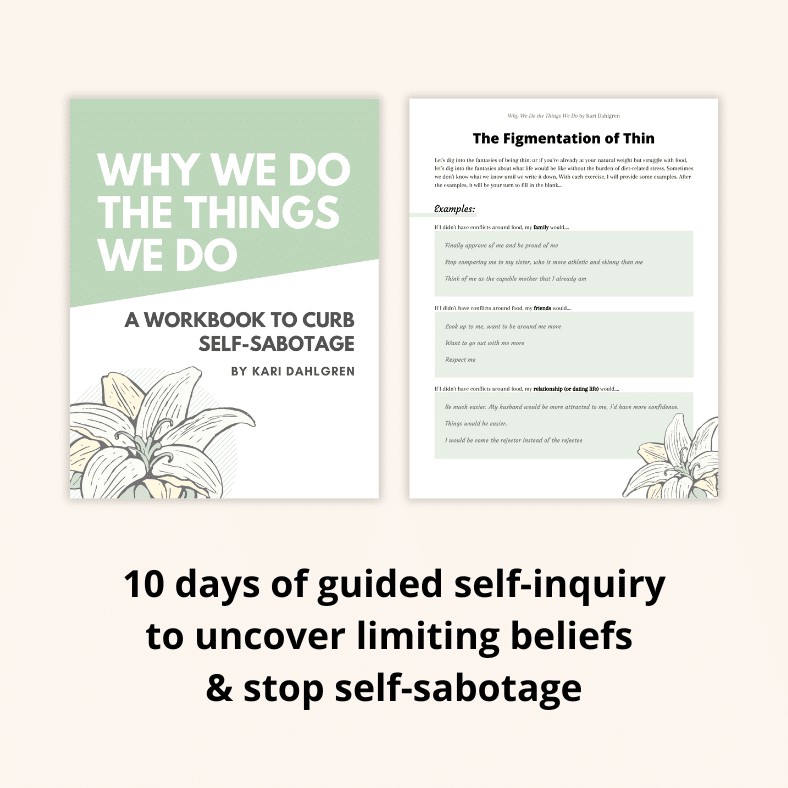
I really loved your article. Like you said I do know what’s healthy and I have used the techniques you have mentioned at home . I struggle on weekends and social situations where I forget all my psychological tricks to not binge or I ignore them. I need to work on this
Thanks for sharing Uma! I am glad you’re already practicing some of these techniques at home, and I wonder if in time they will help with the more challenging occasions like the weekends and social situations, which are indeed more complex than when we are at home. I hope you are offering yourself lots of self-compassion as you navigate this journey. You’re using your tools!! And that alone is worth celebrating. Keep on 🙂